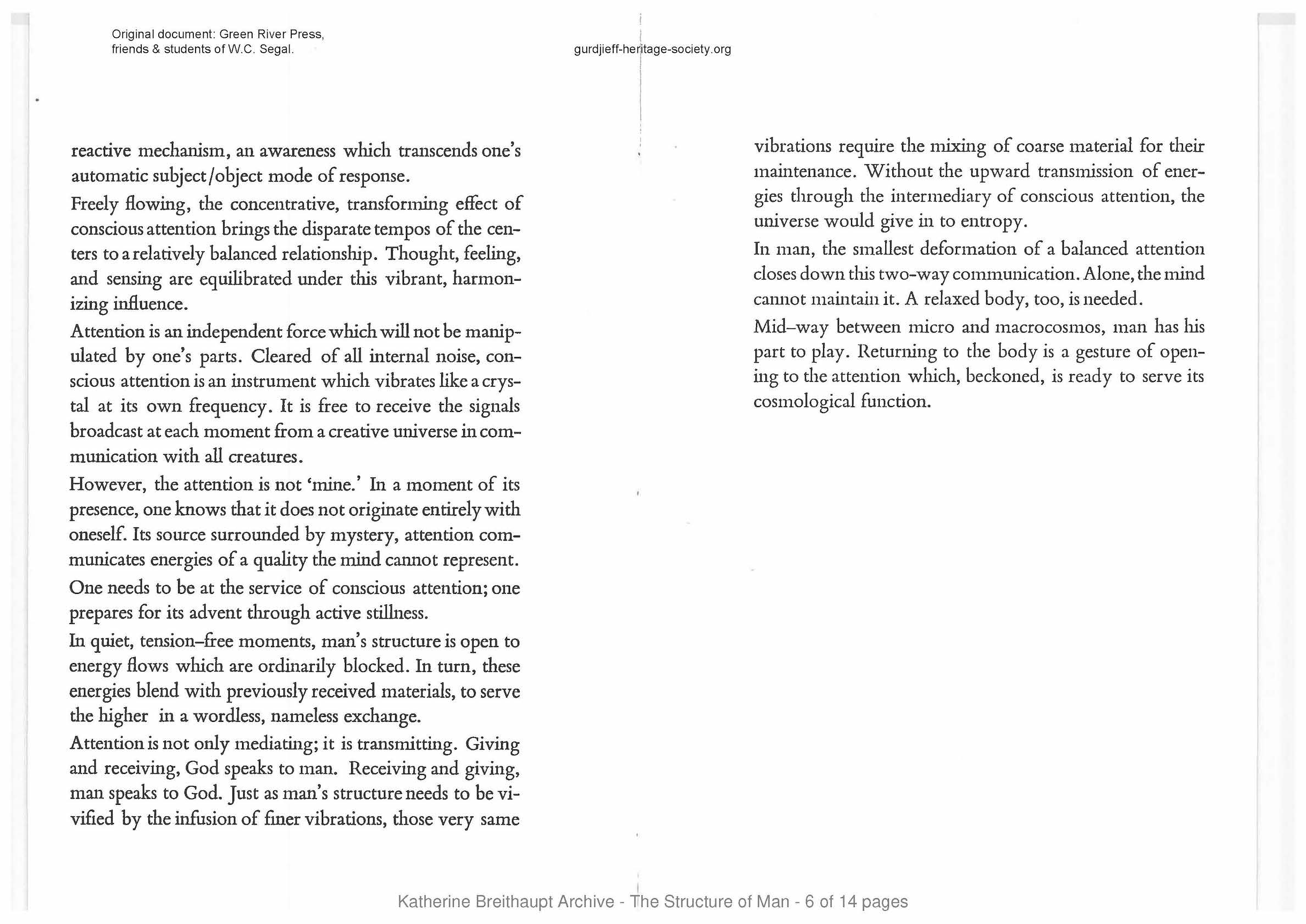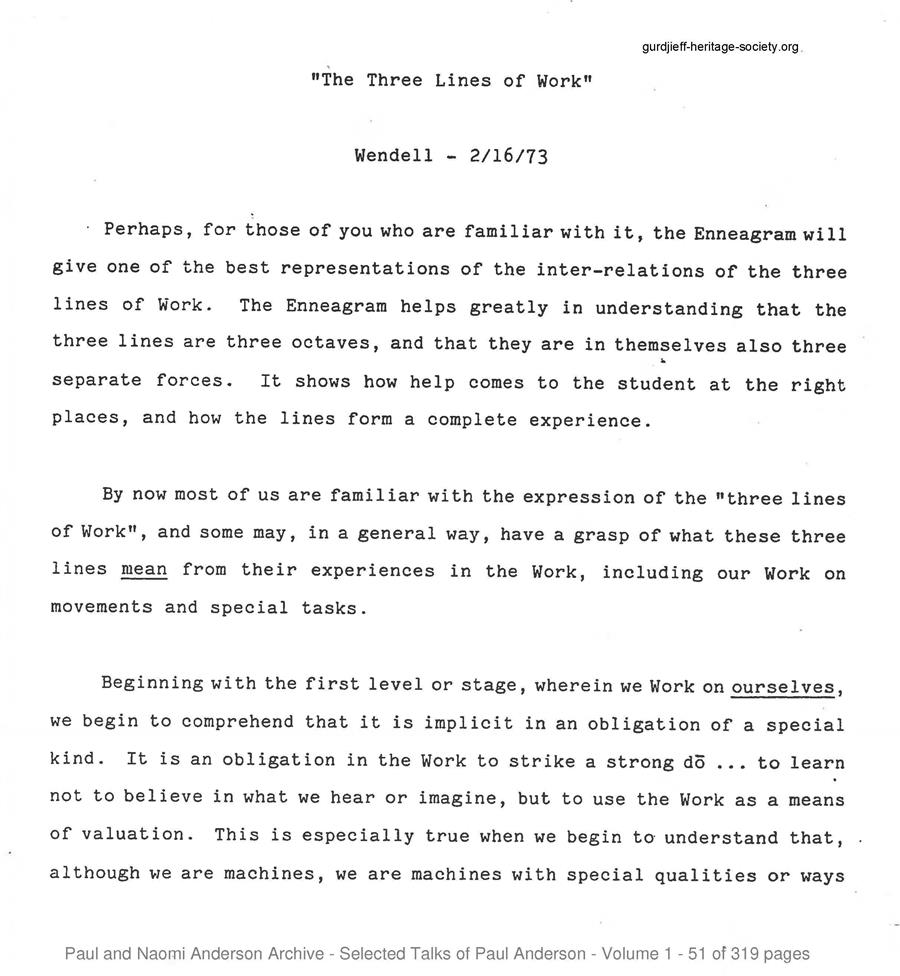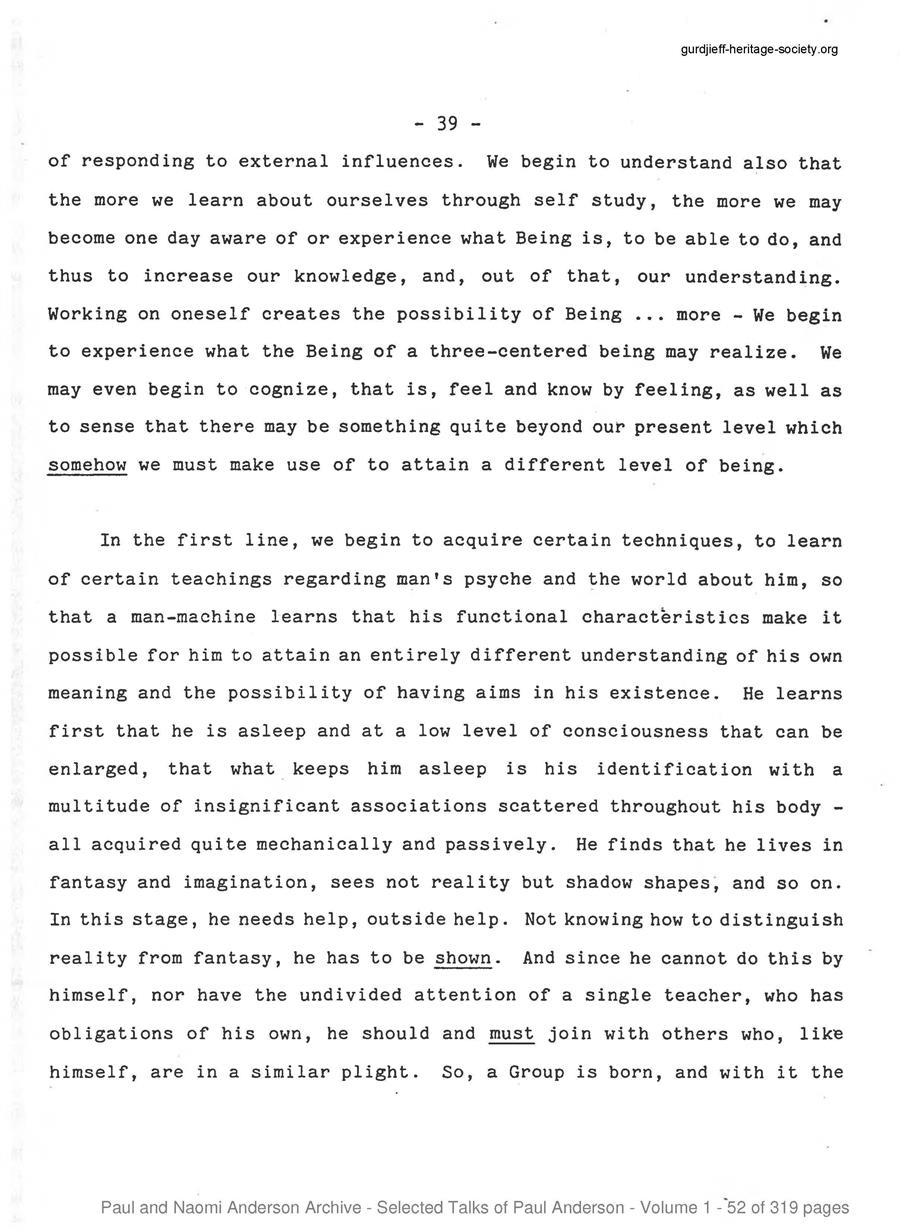Welcome to the Gurdjieff Heritage Society Archive Excerpts page.
We will be surfacing Archive excerpts in the coming months on this page. We hope this will provide a simple way for friends and supporters of the GHS, as well as students of Gurdjieff’s teachings worldwide, to access some select content from these remarkable collections.
Processing the raw materials entrusted to the GHS takes time, effort and funds. Please consider supporting the work of the GHS by making a donation.
If you are not already, we encourage you to become a member, and explore the amazing spectrum of materials that comprise the Gurdjieff Heritage Society Archives.
~ GHS Admin
November 2022 Katherine Breithaupt Archive Excerpt
To learn more about the Breithaupt Archive in specific, please visit the Katherine Breithaupt Archive page on this website. To access the full Breithaupt Archive and many other collections, please become a Gurdjieff Heritage Society member.
If you are already a member and wish to visit this archive directly, please sign in here.
ABOUT
Katherine Rodomar Breithaupt was a member of Lord Pentland’s Group in New York in the 1950s. She took part in Movements demonstrations, and spent many work weekends at Mendham. She was a close friend of both Jessmin and Dushka Howarth. Her collection contains early copies of manuscripts and books, newspaper articles, notes, and a photo of Mdm. de Hartmann. This collection was donated to the GHS by her daughter, Kate Breithaupt.
Archive Excerpt: The Structure of Man, Attention (Segal) pp. 5-6 of 14
(plain text version below the image)


gurdjieff-heritage-society.org
Original document: Green River Press, friends & students of W.C. Segal.
Text reproduced from the image:
ATTENTION
II
Each day we hear: ‘pay attention, give attention,
be attentive, attend to.’ The key with power to
change, attention bridges the gap between man
and higher forces, sustains and is sustained by
the ongoing interplay of body / mind energies.
Focusing, sharpening, and heightening recepti-
vity, conscious attention restores and strengthens,
makes meaningful the structure of man.
ATTENTION is the quintessential medium to reveal man’s dormant energies to himself. Whenever one witnesses the state of the body, the interplay of thought and feeling, there is an intimation, however slight, of another current of energy. Through the simple act of attending, one initiates a new alignment of forces.
Maintenance of a conscious attention is not easy. The movement, the obligations of day-to-day existence constantly distract. With no base of operations, no home in one’s organism, the attention serves random thoughts, feelings, and appetites which conflict and tyrannize each other.
Sensation of parts or the whole of the body can anchor the attention, provide it with a kind of habitat. The structure, becoming more sensitive, helps to unify attention, so it is less liable to veer into mental channels that consume its power. In turn, perceptions and sensations are quickened, insights are multiplied.
Opening to the force of attention evokes a sense of wholeness and equilibrium. One can glimpse a possibility of a state of awareness immeasurably superior to that of the reactive mechanism, an awareness which transcends one’s automatic subject/object mode of response.
Freely flowing, the concentrative, transforming effect of conscious attention brings the disparate tempos of the centers to a relatively balanced relationship. Thought, feeling, and sensing are equilibrated under this vibrant, harmonizing influence.
Attention is an independent force which will not be manipulated by one’s parts. Cleared of all internal noise, conscious attention is an instrument which vibrates like a crystal at its own frequency. It is free to receive the signals broadcast at each moment from a creative universe in communication with all creatures.
However, the attention is not ‘mine.’ In a moment of its presence, one knows that it does not originate entirely with oneself. Its source surrounded by mystery, attention communicates energies of a quality the mind cannot represent.
One needs to be at the service of conscious attention; one prepares for its advent through active stillness.
In quiet, tension-free moments, man’s structure is open to energy flows which are ordinarily blocked. In turn, these energies blend with previously received materials, to serve the higher in a wordless, nameless exchange.
Attention is not only mediating; it is transmitting. Giving and receiving, God speaks to man. Receiving and giving, man speaks to God. Just as man’s structure needs to be vivified by the infusion of finer vibrations, those very same vibrations require the mixing of coarse material for their maintenance. Without the upward transmission of energies through the intermediary of conscious attention, the universe would give in to entropy.
In man, the smallest deformation of a balanced attention closes down this two-way communication. Alone, the mind cannot maintain it. A relaxed body, too, is needed.
Mid-way between micro and macrocosmos, man has his part to play. Returning to the body is a gesture of opening to the attention which, beckoned, is ready to serve its cosmological function.
Katherine Breithaupt Archive – The Structure of Man – pp. 5-6 of 14 pages
To learn more about the Breithaupt Archive in specific, please visit the Katherine Breithaupt Archive page on this website. To access the full Breithaupt Archive and many other collections, please become a Gurdjieff Heritage Society member.
October 2022 Paul and Naomi Anderson Archive Excerpt
From the Paul and Naomi Anderson Archive. To access the full Anderson Archive and many other collections, please become a Gurdjieff Heritage Society member.
If you are already a member and wish to visit this archive directly, please sign in here.
ABOUT
Members of the Orage groups in New York, Paul and Naomi Anderson were also with Gurdjieff at the Institute in France. Gurdjieff visited them in Washington, D.C. where they were instructed to organize and run groups. Among the original members of the Gurdjieff Foundation in New York, the Andersons later went their own way in keeping with their own instructions from Mr. Gurdjieff. This collection contains several of Mr. Anderson’s unpublished writings and talks.
Archive Excerpt: Selected Talks of Paul Anderson, vol. 1 (p51-53 partial)



Paul and Naomi Anderson Archive - Selected Talks of Paul Anderson - Vol 1 (p51-53 partial) Text reproduced from the image. "The Three Lines of Work" Wendell - 2/16/73 Perhaps, for those of you who are familiar with it, the Enneagram will give one of the best representations of the inter-relations of the three lines of Work. The Enneagram helps greatly in understanding that the three lines are three octaves, and that they are in themselves also three separate forces. It shows how help comes to the student at the right places, and how the lines form a complete experience. By now most of us are familiar with the expression of the "three lines of Work", and some may, in a general way, have a grasp of what these three lines mean from their experiences in the Work, including our Work on movements and special tasks. Beginning with the first level or stage, wherein we Work on ourselves, we begin to comprehend that it is implicit in an obligation of a special kind. It is an obligation in the Work to strike a strong do ... to learn not to believe in what we hear or imagine, but to use the Work as a means of valuation. This is especially true when we begin to understand that, although we are machines, we are machines with special qualities or ways - 39 - of responding to external influences. We begin to understand also that the more we learn about ourselves through self study, the more we may become one day aware of or experience what Being is, to be able to do, and thus to increase our knowledge, and, out of that, our understanding. Working on oneself creates the possibility of Being ... more - We begin to experience what the Being of a three-centered being may realize. We may even begin to cognize, that is, feel and know by feeling, as well as to sense that there may be something quite beyond our present level which somehow we must make use of to attain a different level of being. In the first line, we begin to acquire certain techniques, to learn of certain teachings regarding man's psyche and the world about him, so that a man-machine learns that his functional characteristics make it possible for him to attain an entirely different understanding of his own meaning and the possibility of having aims in his existence. He learns first that he is asleep and at a low level of consciousness that can be enlarged, that what keeps him asleep is his identification with a multitude of insignificant associations scattered throughout his body - all acquired quite mechanically and passively. He finds that he lives in fantasy and imagination, sees not reality but shadow shapes, and so on. In this stage, he needs help, outside help. Not knowing how to distinguish reality from fantasy, he has to be shown. And since he cannot do this by himself, nor have the undivided attention of a single teacher, who has obligations of his own, he should and must join with others who, like himself, are in a similar plight. So, a Group is born, and with it the - 40 - second stage of Work comes into existence.
From the Paul and Naomi Anderson Archive. For an audio sample and to learn more about the Paul and Naomi Anderson Archive in specific, please visit the Paul and Naomi Anderson Archive page on this website. To access the full Anderson Archive and many other collections, please become a Gurdjieff Heritage Society member.
September 2022 Kathryn Hulme Archive Excerpts
Excerpt No 1: New Year with G. by K. Hulme Jan 2 1936 (p.1 partial)
From the Kathryn Hulme Archive. To learn more about the Hulme Archive in specific, please visit the Kathryn Hulme Archive page on this website. To access the full Hulme Archive and many other collections, please become a Gurdjieff Heritage Society member.

GHS-excerpt1-2022-doc-007-01003-p1-partial-of-3-K-Hulme Text reproduced from the image. Format and typing details (including "errors") have been retained.
#2 January 2 193() New Year with Gurdjieff. I want to tell you about it just the way it happened, because seeing him made the day for me, and perhaps will make the year. Gloomy yesterday and rainy, I had no feeling it was the beginning of a New Year or the beginning of anything for that matter. Mi-chemin with every one of my problems, Yesterday was just Wednesday, no different from the previous day, Tuesday. I phoned Solita, she had to go to his house around 1 P.M. - but I said, Maybe if we tried to catch him in the Café de la Paix, I’d have a chance to see him too. Solita said, Yes, but I’ll need a half hour to dress etc. . . .then I haggled, But in a half hour perhaps he will have left the cafe (been leaving before noon these days) and we’ll have the trip for nothing. . . back and forth haggling and debating, no direction, no Action anywhere (in me, I mean) and finally hung up deciding not to go to the cafe. . . . . Then upstairs in my room, walking around aimless and indirect. Some of his chapters walked back and forth in my mind – remember the “gallery” chapters, people who were “turning points” in his life and how he travelled days and miles to find them? Prince Liubovedski, Skridloff, etc? Remember the 21 day ride through Turkestan, blindfolded, when he went to a monastery where he thought he might hear something? I thought of those chapters and suddenly the shocking shame of my attitude came over me – me, unwilling to take a bus ride to the Opera on mere chance that he would be in the cafe, unwilling to give up half an hour and 3 bus tickets on the CHANCE OF SEEING G - I was out of my work clothes in 3 minutes, 2 minutes later dressed and going out the door. It was just 11 when I walked in the cafe. He was sitting there, alone. I sat at a table near, waiting until he would see me. His eyes examining every person who came in the cafe found me quickly – Crocodile, he called – and I went over to his table – straight into the most beautiful smile I ever saw. I felt his mood, friendly, glad for company, and touched with a special kind of gentleness he has on holidays like Christmas and New Year – it was the Perfect Moment to find him alone, like the first time I found him alone after Jane left. . . and I was so surprised that at long last an impulse had been correct, I kept saying to myself, Well, Katie Hulme I beat your inertia that time, I put it over on you, Katie Hulme. . . .and felt near to tears – just for the emotion of having made Katie Hulme do a right thing at a proper moment. Tears of victory maybe.
Biographical Note:
Kathryn Hulme (1900 – 1981) studied with G.I. Gurdjieff in a Work group known as the Rope, which also included Solita Solano, Alice Rohrer, Elizabeth Gordon, Jane Heap, Margaret Caroline Anderson and Louise Davidson. Notes from these meetings can be found in GURDJIEFF AND THE WOMEN OF THE ROPE: Notes of Meetings in Paris and New York
1935–1939 and 1948–1949, ISBN: 978-0-9559090-6-1, Book Studio, 2012.
Her own spiritual journey and experiences with Gurdjieff are described in her book The Undiscovered Country: A Spiritual Adventure, first published by Little, Brown & Co. (Boston USA/Toronto CA), 1967; and most recently published by Book Studio. UNDISCOVERED COUNTRY: A Spiritual Adventure, ISBN: 978-0-9559090-8-5, Book Studio, 2012.
Both titles can be found in multiple formats on Amazon through the Book Studio website: https://bookstudio.co.uk
Kathryn Hulme was an American author and memoirist most noted for her best-selling novel The Nun’s Story, a fictionalized biographical account of Belgian nurse and former nun Marie Louise Habets, who became her lifelong companion.
Hulme is also the author of Wild Place, a description of her experiences as the UNRRA Director of the Polish Displaced Persons camp at Wildflecken, Germany, after World War II, where she met Habets. This work won the Atlantic Non-Fiction Award in 1952.
She authored many other books, including a fictionalized autobiographical work We Lived as Children.
Excerpt No 2: K. Hulme: Conversation with Gurdjieff 1937 (p48 of 256)

GHS-excerpt2-2022-doc-007-01004-k-hulme-conversation-with-g-1937-p48of256
Text reproduced from the image. Format and typing details (including "errors") have been retained.
Some part of our psychology bears the
same relation to us as the moon bears to
our psychical life.
--------------------------------------------------
It is only when Wish becomes a Need that
it becomes the Magical Evocative.
You say, What do you want? Nothing.
You say, What do you need? Everything.
I don’t want food but I need it.
Wants are real only when they are needs,
they are imaginary when not.
We die because we don’t get all we need to
live.
Find out the needs of our lives and become
conscious of them.
“They lived happily everafter”. What do I
need to enable me to live happily everafter
and what is happily and what is everafter?
To “live happily everafter” – the discovery
and adoption of the means to arrive at
immortality.
Find out if the means exist, where found and
how to use them.
Few of us want what we need and few of us
need what we want.
What we want, the moon wants, what we need –
the sun needs. Memory belongs to the moon,
awareness to the sun.
The child in the womb sings “I remember who I am
– but the first breath, the first cry, means
“I have forgotten who I am.
And we keep on forgetting until we die.
From the Kathryn Hulme Archive. To learn more about the Hulme Archive in specific, please visit the Kathryn Hulme Archive page on this website. To access the full Hulme Archive and many other collections, please become a Gurdjieff Heritage Society member.